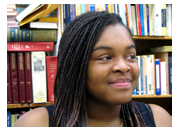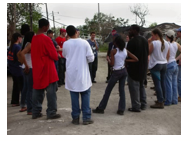
New York City Youth Help Storm Victims Rebuild Homes
by Abe Louise Young
NEW YORK/NEW ORLEANS—Early in the morning in the muggy Southern light, 23 kids from New York City donned white chemical-protection suits and facemasks. They were about to do research in a whole new way: to put their bodies and minds to work in a disaster zone, and simultaneously, to investigate the racial and political landscape that created it. They arrived on the scene with the hypothesis that individuals can—and must—build a better society. After eight days of life-changing work, they left with certain proof.
 “It gave me a sense of drive because I feel like now I can’t let myself down. I can’t, because I would let down so many people,” Jasmine Hopkins, 17, says.
“It gave me a sense of drive because I feel like now I can’t let myself down. I can’t, because I would let down so many people,” Jasmine Hopkins, 17, says.
Hopkins is a student at Urban Academy, a flagship small school in New York known for its progressive, hands-on curriculum. It serves an equal racial mix of African-American, Latino, and white students. The school has a long history of activism, and regularly engages students in real-world problemsolving.
Like most of the young volunteers, Jasmine was in a class about action-based research when Hurricane Katrina struck. Avram Barlowe, a teacher of history who helped found the school, had just launched a popular course called “Talk is Cheap,” in which students interview activists. The class quickly switched its focus to investigating the cultural, economic, and racial aspects of the Katrina disaster. Barlowe says, “Students both inside and outside of the class wanted to focus on these issues. It was on everyone’s mind.”
These intrepid, committed teenagers did not let it stay only on their minds, however. They put their hands, feet, and voices to work. Quickly, they agreed to do whatever it took to go to New Orleans and join the rebuilding movement, themselves.
Making Disaster Personal
Making a disaster of such a great scale personal and concrete is invaluable learning—and hard work.
The effort began in New York, with Urban students interviewing scores of activists, and helping to organize relief for evacuees. They contacted their legislators and read policy papers. To raise money for their trip, the students held a Walk-a-Thon, a Run-a-Thon, and a Bike-a-Thon. They wrote a grant proposal and won $4,500 from WKCD’s student action research program to support their vision.

By spring break, they were ready for eight days of work. The trip was bare-bones. Students slept on the floor at St. Augustine’s Church and showered at Tulane University. In the mornings, they gathered in a circle to speak about their feelings and make sense of the day ahead.
The team had planned to bring their knowledge of student-centered education to the educational scene in New Orleans—and to help renovate a flooded school building. But like many who arrive at a disaster scene, they had to adapt their expectations to circumstances on the ground. The bare-bones school was flooded, its desks and chairs upturned in tangled piles.
If the time was not right to create a school, one thing was clear: People needed homes to live in. Shell-shocked survivors simply needed people to talk to. And a progressive community group, the People’s Hurricane Relief Fund, needed organizers to spread the word to residents about fighting for their rights.
The students from Urban Academy shifted their plans, entered the city at its level—and dove in.
Compassion, Community, and Crowbars
 Their first lessons were physical: floodwater marks, and the odor of mold and garbage. Deciphering spray-paint markings, tearing down a house to its studs, maneuvering a wheelbarrow full of moldy sheetrock and insulation, using a power drill and a crowbar.
Their first lessons were physical: floodwater marks, and the odor of mold and garbage. Deciphering spray-paint markings, tearing down a house to its studs, maneuvering a wheelbarrow full of moldy sheetrock and insulation, using a power drill and a crowbar.
After the emotional check-in meeting each morning, the students divided into two teams. One team—dressed in white Tyvek suits, with green rubber gloves, hardhats and face masks—gutted houses in the Ninth Ward.
The other group pounded the pavement for the People’s Hurricane Relief Fund, encouraging residents to come to Survivor’s Council meetings. They had conversations with strangers, aiming for a sustaining exchange. “We care about you, and we haven’t forgotten you”was the message.
“I hope I was able to bring support,” Jasmine reflects. “I did a couple gut-outs of the houses, and then I did outreach in the neighborhood and talked to the people. The people were so nice. They were suffering but they didn’t let that show, really. They were so strong. I wish I could be like them—they didn’t even say, “I want this back. I want this back.” They said, “So you’re down here volunteering? Thank you. You should come back in a couple of months and it may be better.”
On the last day, a team of students gutted an entire house from top to bottom—by themselves, in near silence. When greeted with the tearful embrace of the homeowners, they knew the power of their support.
“It was a transforming experience for the kids on many, many levels,” says Avram Barlowe. “It exceeded my expectations in terms of raising their social and political awareness. There was a solidarity they achieved together in doing this work and meeting the people whose homes they had just gutted out. What was very clear was the sense that they did something that was very, very valuable.”
Back in New York, the students from Urban Academy don’t let their eight-day voyage fade into memory. They have created a series of documentary photographs and a short DVD, and are busy educating their peers.
They get on the phone, calling their Congressional representatives to ask, “Where is the money promised for evacuees? What’s happening to public housing in New Orleans?” One student, an artist, plans to return and do a mural in New Orleans. Jasmine Hopkins is determined to move to New Orleans one day. And the school is already planning its next trip down to the Crescent City.
New York and New Orleans are a thousand miles apart. But in the hearts of this diverse, dedicated group of teenagers, they are close neighbors.
Click below to:
Watch a DVD by Urban Academy students about their relief work and its impact on their lives [broadband] [dialup]
View the photographic essay on New York City students’ New Orleans experience [broadband] [dialup]


